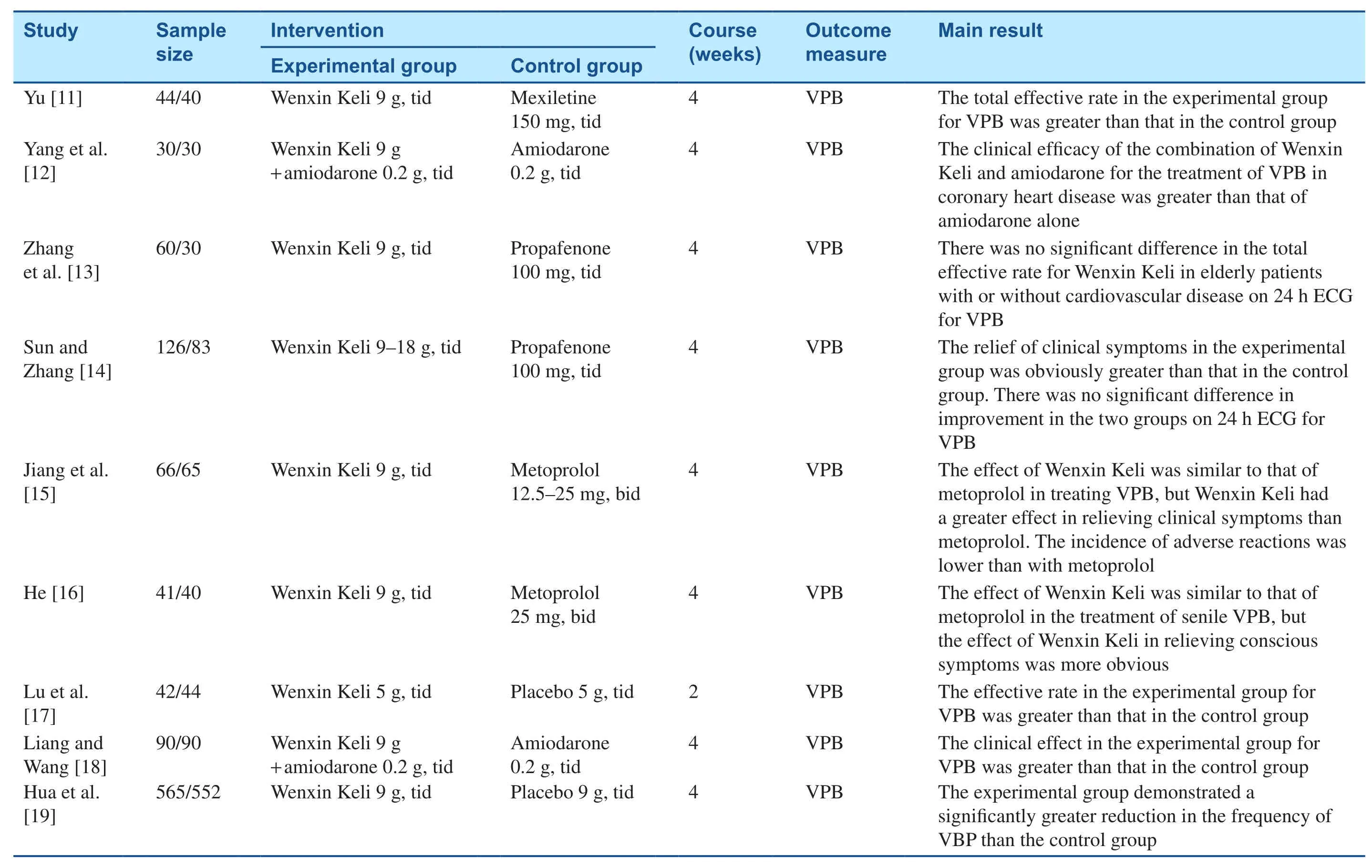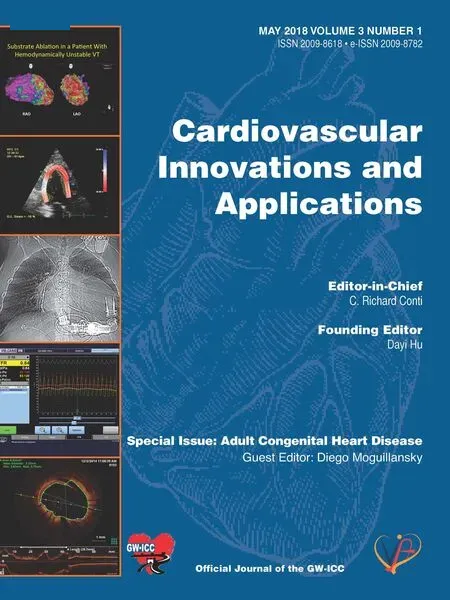Traditional Chinese Medicine ls Widely Used for Cardiovascular Disease
Yanwei Xing, MD, PhD, Hector Barajas-Martinez, PhD and Dan Hu, MD, PhD3,4Guang’ Anmen Hospital, Chinese Academy of Chinese Medical Sciences, Beijing 00053, China
2Global Genetics Corporation, Ventura, CA 93003, USA
3Department of Cardiology and Cardiovascular Research Institute, Renmin Hospital of Wuhan University, Wuhan 430060,China
4Hubei Key Laboratory of Cardiology, Wuhan 430060, China
A review article by Hao et al.[1] has attracted great attention among those familiar with traditional Chinese medicine (TCM) owing to a clinical evidence–based approach to this topic.It systematically and elegantly evaluated the efficacy and safety of TCM for cardiovascular disease, as well as the pharmacological effects and potential mechanisms of active TCM ingredients on the cardiovascular system [1].We sincerely congratulate the authors since the article has had huge repercussions in the international academic community, and it will promote the application of TCM to the world.Meanwhile, we believe this article could have been more comprehensive if the following points had been addressed.
Firstly, there is no summary of nonpharmacotherapy in TCM, including acupuncture, moxibustion,Qigong, and Tai Chi.Recently, for instance, several large-scale randomized controlled trials (RCTs) of acupuncture proved its clinical effect on migraine[2], constipation [3], polycystic ovary syndrome [4],and urinary incontinence [5].In the cardiovascular fi eld, acupuncture has shown its efficacy and safety in the treatment of heart failure, hyperlipidemia,and hypertension [6–10].We performed a metaanalysis to evaluate acupuncture for the treatment of arrhythmia compared with existing antiarrhythmic
drugs [9].In 13 trials with 797 patients enrolled,acupuncture, with or without use of an antiarrhythmic drug, displayed a clear benef it in treating ventricular premature beat and sinus tachycardia.

Table 1 Characteristics of R andomized Controlle Trials of Wenxin Kelitrials for Treatment of Ventricular Premature Beats(VBP).
Secondly, arrhythmia-related RCTs were not included.In cardiac electrophysiology, several herbal components, such as Shenmai, acacetin,Shensong Yanxin, and Wenxin Keli, have been proposed as antiarrhythmic drugs.Similar to amiodarone, the latter two have been verified to have effects on multiple ion channels and to modulate cardiac autonomic nervous function.In 49 RCTs with 4610 patients enrolled, Wenxin Keli was shown to be more effective than other available treatments of arrhythmia, angina, and heart failure[10].We selected Wenxin Keli for the treatment of ventricular premature beats.The characteristics of RCTs of Wenxin Keli are shown in Table 1 [11–19].Shensong Yanxin is another well-known compound,fi rst described in the 16th century, and recommended by two Chinese experts’ consensuses [20, 21].In a meta-analysis of 22 trials involving 2347 paroxysmal atrial fi brillation patients, it appeared to be beneficial [22].Another study showed that in 465 study participants, Shensong Yanxin had the benef its of ventricular premature beat suppression and cardiac function improvement with good adherence on a background of standard treatment for heart failure[23].Shensong Yanxin also significantly increased the heart rate in patients with bradycardia without severe side effects [24].
In addition, it is controversial that the active ingredients of TCM have been confined to TCM in recent decades.Many people believe that TCM should contain only Chinese herbal compounds and should be guided by the theory of syndrome differentiation,since TCM is usually prescribed as a complex formula by the practitioner on a personalized basis.With the development of modern biomedical technology, the pharmacological effects and the underlying mechanisms of some active ingredients of TCM have been elucidated or assessed.For instance, after reviewing 19 natural drug therapies for antiarrhythmic effects,we summarized 18 active ingredient therapies, such as alkaloids, fl avonoids, saponins, quinones, and terpenes [25].This gives us new concepts and challenges in the use of natural drug agents.Thus we support the view that the active ingredients of TCM are an intrinsic part of TCM, which will help to enrich and develop the practice of TCM in the future [1].
Conflict of lnterest
The authors declare that they have no conflicts of interest.
REFERENCES
1.Hao P, Jiang F, Cheng J, Ma L,Zhang Y, Zhao Y.Traditional Chinese medicine for cardiovascular disease: evidence and potential mechanisms.J Am Coll Cardiol 2017;69(24):2952–66.
2.Zhao L, Chen J, Li Y, Sun X,Chang X, Zheng H, et al.The long-term effect of acupuncture for migraine prophylaxis: a randomized clinical trial.JAMA Intern Med 2017;177(4):508–15.
3.Liu Z, Yan S, Wu J, He L, Li N,Dong G, et al.Acupuncture for chronic severe functional constipation: a randomized trial.Ann Intern Med 2016;165(11):761–9.
4.Wu XK, Stener-Victorin E, Kuang HY, Ma HL, Gao JS, Xie LZ,et al.Effect of acupuncture and clomiphene in Chinese women with polycystic ovary syndrome:a randomized clinical trial.JAMA 2017;317(24):2502–14.
5.Liu Z, Liu Y, Xu H, He L, Chen Y, Fu L, et al.Effect of electroacupuncture on urinary leakage among women with stress urinary incontinence: a randomized clinical trial.JAMA 2017;317(24):2493–501.
6.Ni YM, Frishman WH.Acupuncture and cardiovascular disease: focus on heart failure.Cardiol Rev 2018;26(2):93–8.
7.Yuan M, Liu Z, Xu B, Lu S.Effects of acupuncture on 1528 patients with obesity complicated with hyperlipidemia in different obesity levels.Zhongguo Zhen Jiu 2016;36(8):807–11.
8.Terenteva N, Chernykh O,Sanchez-Gonzalez MA, Wong A.Acupuncture therapy improves vascular hemodynamics and stiffness in middle-age hypertensive individuals.Complement Ther Clin Pract 2018;30:14–8.
9.Li Y, Barajas-Martinez H, Li B,Gao Y, Zhang Z, Shang H, et al.Comparative effectiveness of acupuncture and antiarrhythmic drugs for the prevention of cardiac arrhythmias: a systematic review and meta-analysis of randomized controlled trials.Front Physiol 2017;8:358.
10.Wang X, Wang Y, Feng Xi, Lu Y,Zhang Y, Wang W, et al.Systematic review and meta-analysis of randomized controlled trials on Wenxin Keli.Drug Des Devel Ther 2016;10:3725–36.
11.Yu SY.Clinical efficacy of Wenxin Keli on premature beats.Chin J Clin 2004;32(6):62.
12.Yang J, He JS, Yang XY.Clinical observation of Wenxin Keli plus amiodarone combination therapy on coronary heart disease complicated by ventricular premature beats.J Guangxitradit Chin Med Univ 2005;8(3):18–20.
13.Zhang XJ, Ge N, Huang XL, Wu JH, Zhang YL, Wang S, et al.The effect of Wenxin Keli on arrhythmia of cardiovascular disease in elderly.West China Med J 2005;20(4):263–4.
14.Sun G, Zhang B.Clinical observation of Wenxin Keli in treating 126 cases with ventricular premature beats.Chin J Basic Med Tradit Chin Med 2005;11(10):793–4.
15.Jiang QL, Yang CL, Wei X, Lu X,Wu QA.A comparison of Wenxin Kelitometoprolol in treatment of ventricular premature beats.Pract Clin J Integr Tradit Chin West Med 2007;7(4):12–3.
16.He CF.A comparison of Wenxin Kelito metoprolol in treatment of symptoms of ventricular premature beats.Chin J Integr Med CardioCerebrovasc Dis 2008;6(1):98–9.
17.Lu ZH, Wu XB, Liu L, Li XP, Qiu XL, Lin YZ, et al.The effect of Wenxin Keli on acute coronary syndrome complicated by arrhythmias:a multi-center clinical trial.J Clin Med Pract 2010;14(1):59–62.
18.Liang T, Wang XM.Clinical observation of Wenxin Keli in treating 90 cases with ventricular premature beats.Guangxi Med J 2013;34(6):795–6.
19.Hua W, Gao RL, Zhao BC, Wang J,Chen XH, Cai C, et al.The efficacy and safety of Wenxin Keli in patients with frequent premature ventricular contractions: a randomized, doubleblind, placebo-controlled, parallelgroup, multicenter trial.Chin Med J 2015;128(19):2557–64.
20.Cao KJ, Chen KP, Chen ML, Dong JZ, Hua W, Huang CX, et al.Current knowledge and management recommendations of atrial fi brillation – 2015.Chin J Card Arrhythm 2015;19(5):321–84.
21.Chao KJ, Chen ML, Jiang ML, Jiang H, Yao Y, Wang ZL, et al.Chinese expert consensus on ventricular arrhythmias.Chin J Card Arrhythm 2016;20(4):279–326.
22.Chen G, Wei B, Wang J, Feng B, Li Z, Zhang Z, et al.Shensong yangxin capsules for paroxysmal atrial fi brillation: a systematic review of randomized clinical trials.PLoS One 2016;11(3):e0151880.
23.Wang X, Hu D, Dang S, Huang H,Huang CX, Yuan MJ, et al.Effects of traditional Chinese medicine Shensong Yangxin capsules on heart rhythm and function in congestive heart failure patients with frequent ventricular premature complexes:a randomized, double-blind, multicenter clinical trial.Chin Med J(Engl) 2017;130(14):1639–47.
24.Liu Y, Li N, Jia Z, Lu F, Pu J.Chinese medicine shensongyangxin is effective for patients with bradycardia: results of a randomized, double-blind, placebocontrolled multicenter trial.Evid Based Complementary Altern Med 2014;2014:605714.
25.Li J, Hu D, Song X, Han T, Gao Y, Xing Y.The role of biologically active ingredients from natural drug treatments for arrhythmias in different mechanisms.Biomed Res Int 2017;2017:4615727.
 Cardiovascular Innovations and Applications2018年2期
Cardiovascular Innovations and Applications2018年2期
- Cardiovascular Innovations and Applications的其它文章
- His Bundle Pacing: Rebirth of an lmportant Technique for Pacing the lntrinsic Conduction System
- Depression in Adults with Congenital Heart Disease: Prevalence, Prognosis,and lntervention
- The Fontan Circulation: Contemporary Review of Ongoing Challenges and Management Strategies
- D-Transposition of the Great Arteries: A New Era in Cardiology
- Heart Transplantation for Adult Congenital Heart Disease: Overview and Special Considerations
- Atrial Arrhythmias lncluding Atrial Fibrillation in Congenital Heart Disease: Mechanisms,Substrate ldentification and lnterventional Approaches
